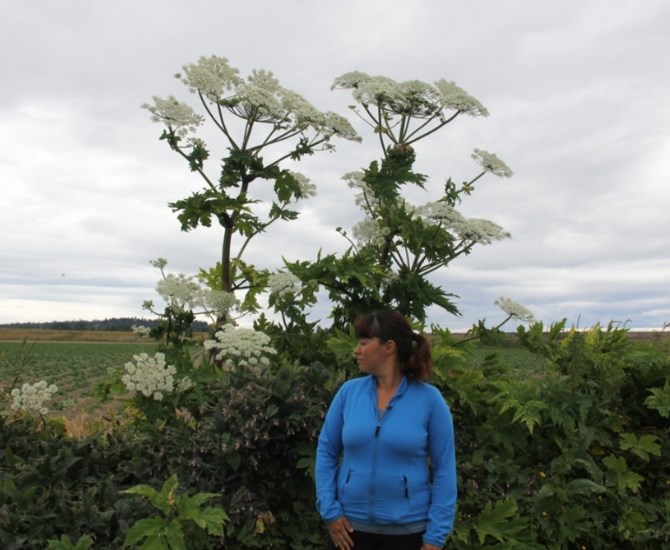
Woman stands next to giant hogweed.
Image Credit: Invasive Species Council of BC
June 21, 2020 - 7:00 PM
Reports of giant hogweed are made in the Thompson-Okanagan region all the time. However, it's often a look-alike native plant, called cow parsnip.
The two plants are sisters, but they have some important differences.
Whereas the worst that will happen if you pull up cows parsnip is mild skin irritation, pulling up a Giant Hogweed could land you in the hospital.
"It’s actually got a sap within its stalk that's photosensitive, so when it’s exposed to sun it’ll cause up to second degree burns on your skin," Gail Wallin, Invasive Species Council of B.C. Executive Director said.
Because it reacts to sunlight, you may not feel the burn until later, sometimes the next day. In rare cases getting the sap in your eyes can cause permanent blindness.
It's uncertain how the invasive plant found its way to B.C., but it has suspected origins in Asia.
"It was intentionally introduced to B.C. as an exotic garden plant," Wallin said. "It’s one of many that we’ve introduced into our gardens thinking that it was a good thing and it’s actually turned out to be a very bad thing."
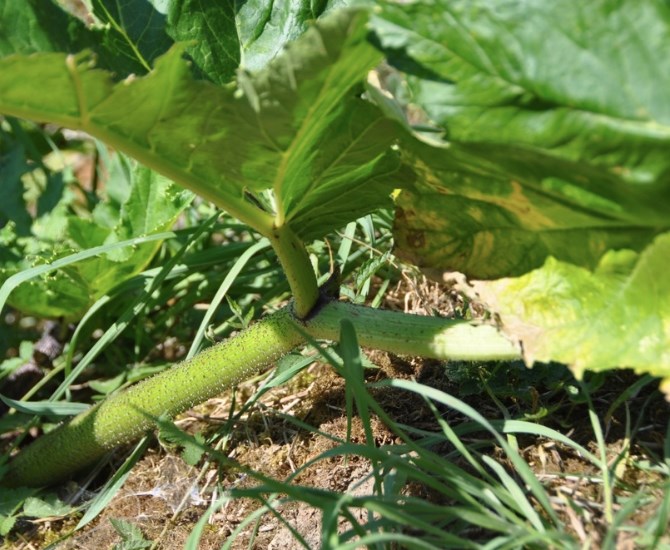
Giant hogweed.
Image Credit: invasive Species Council of BC
Giant hogweed grow up to fifteen feet tall with white flower clusters and large umbrella leaves. They're no friend to ecosystems either.
"Once it becomes established, it creates basically a canopy that keeps out all the good plants down below," she said. "No sun can get through, it’s very aggressive that way."
Giant hogweed is very tolerant of wet environments, common on Vancouver Island, in the Lower Mainland and Fraser Valley. There have been no verified reports of the plant in the Interior, but Wallin stresses that just because it's not reported, doesn't mean it's not around.
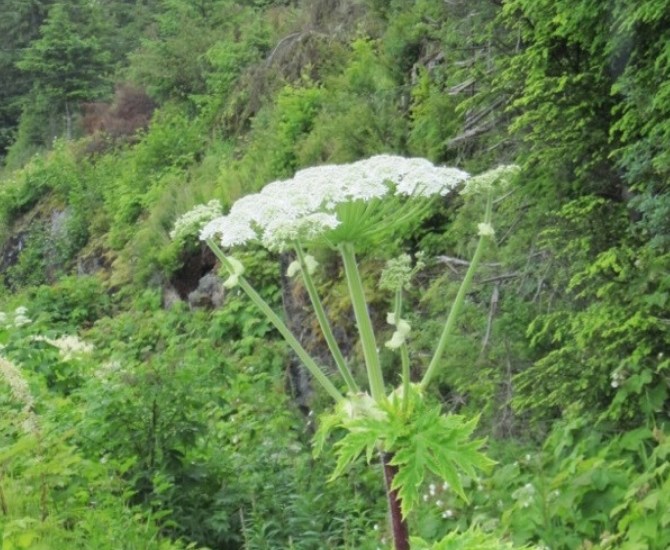
Giant hogweed.
Image Credit: Invasive Species Council of BC
"It's important for people to report, because who knows? The next one could be giant hogweed," she said.
Although cow parsnip does look similar to giant hogweed, there are a couple key differences.
Most notably, cow parsnip only grows to around five feet tall.
To identify more differentiating factors, use this comparison chart.
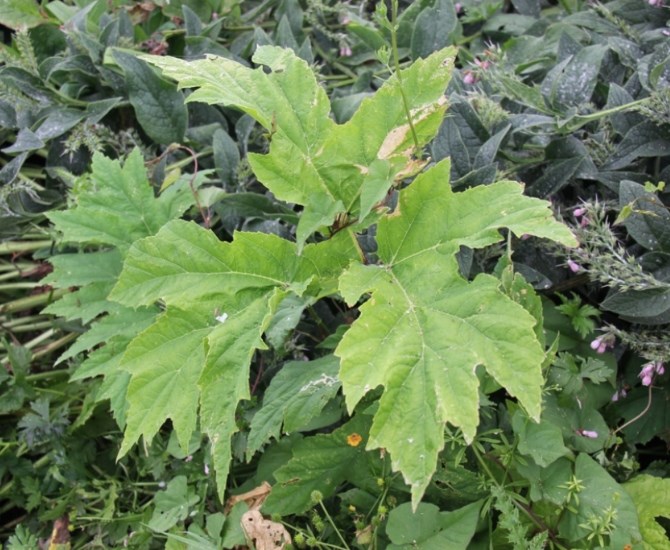
Giant hogweed
Image Credit: Invasive Species Council of BC
Like many invasive species, giant hogweed is hard to eradicate for a number of reasons.
Because they thrive in wet environments, they are often found along shores of water bodies, which makes the options for their removal limited.
"There’s very little tools we have in B.C. and Canada that can treat plants in a wet environment," Wallin said.
"Manual removal is important."
The timing of removal is key to minimize the spread of seeds. The hogweed spreads by releasing 50 to 100 thousand seeds every year.
Because they are very durable, the seeds can remain viable in the soil for up to ten years, even surviving fire and freezing temperatures.
This is why repeated yearly removal of hogweed from the area is important.
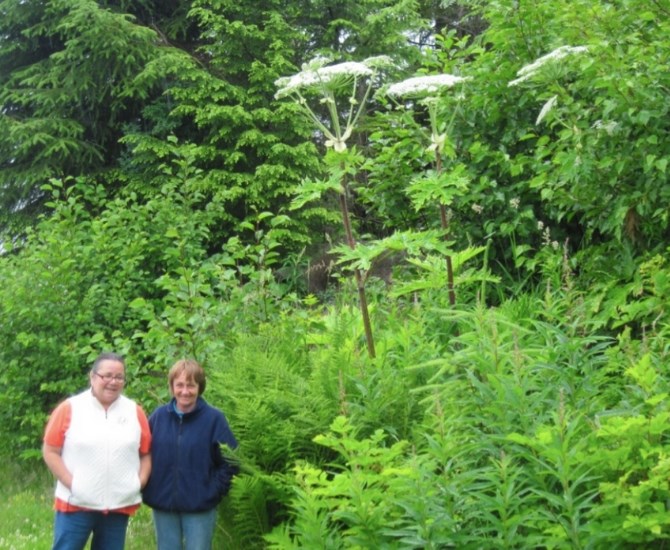
Giant hogweed.
Image Credit: Invasive Species Council of BC
While injecting the stalk of the plants with herbicide is an option for infestations in wet zones, this is a method that requires skilled experts and specialized equipment. Ultimately, physically removing the plants before they spread their seeds is the most viable option.
Giant hogweed has had it's fair share of media attention in previous years, particularly in 2015 when five children in the UK suffered burns from its sap.
The attention has died down in recent years, and progress has been made in raising awareness about the invasive plant.
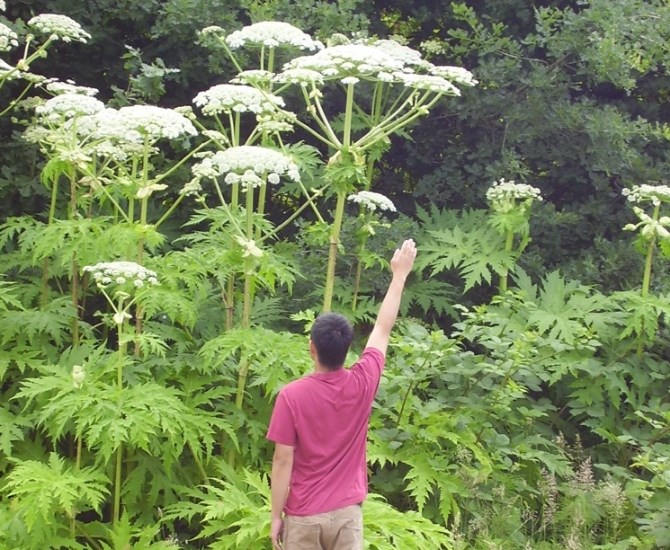
Giant hogweed.
Image Credit: Invasive Species Council of BC
"Local governments, provincial governments, have been taking action action on it and that’s because it’s got the health risk side," Wallin said.
She stressed that when it comes to invasive species like giant hogweed, it's better to over report than not report at all.
READ MORE: Wondering what to do? Stop these pesky plants from invading your yard
If you see a suspected giant hogweed, you can report it through the Invasive Species Council of B.C. here.
In the Okanagan, report through the RDCO by email, over the phone at (250) 469-6218 or submit an online form.
To contact a reporter for this story, email Brie Welton or call (250) 819-3723 or email the editor. You can also submit photos, videos or news tips to the newsroom and be entered to win a monthly prize draw.
We welcome your comments and opinions on our stories but play nice. We won't censor or delete comments unless they contain off-topic statements or links, unnecessary vulgarity, false facts, spam or obviously fake profiles. If you have any concerns about what you see in comments, email the editor in the link above.
News from © iNFOnews, 2020